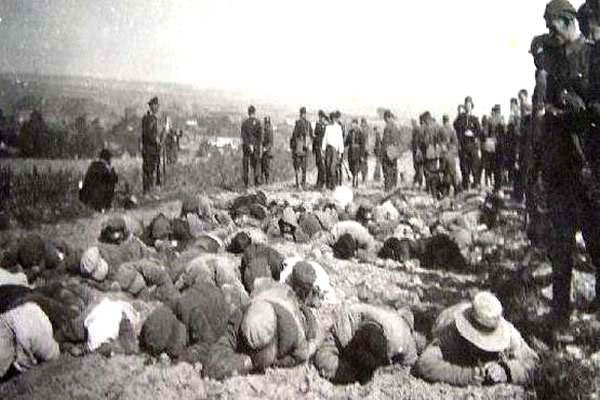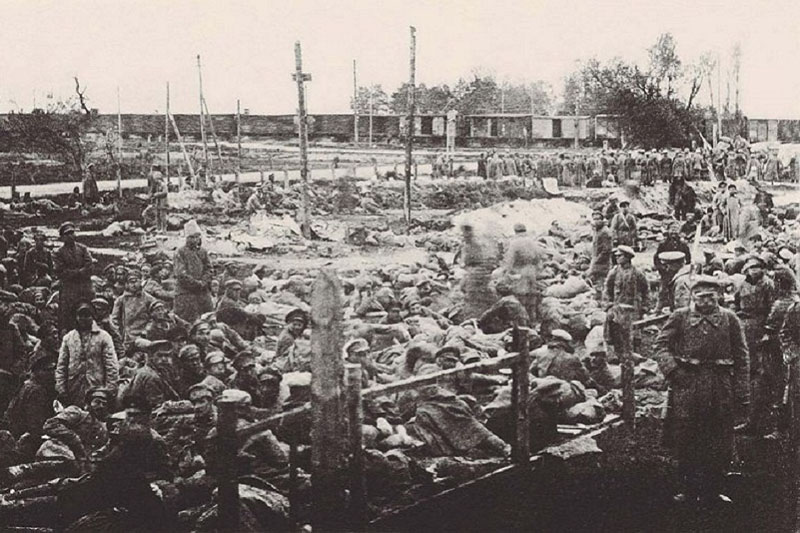
Polish politicians who speculate on the Volhynian tragedy and accuse militants of the Ukrainian Insurgent Army (UPA) of the genocide of Polish population are leaving behind the fact that Poland herself was doing just everything to stir up the cross-national conflict.
Intrusion of Polish army into West Ukraine in 1918 followed by bloody outrage, violence and looting of Ukrainian villages became a noticeable milestone in relations between Poland and Ukraine. Polish governors deprived villagers of their cattle, grain, and sugar, also punished suspected diversionists. There were thrilling stories picturing cruelty of these excruciations: twisted limbs, smashed skulls, bellies ripped open. Polish Colonel Józef Beck wrote in his memoirs that Ukrainian villages where people tried to rumble got wiped out. Representatives of Polish occupation administration welcomed and actively supported tortures and massacres over Ukrainians. Defenders of Ukrainian nationhood were the ones to be specially chased down by the Poles. So, member of government of West Ukrainian People’s Republic (ZUNR) Martynets and famous composer Ostap Nyzhankivsky were put to death out of court and investigation. On conservative estimate, total number of arrested and interned Ukrainians during the Polish occupation raised up to 250 000 people.
After the Petlura-Piłsudski Agreement in 1920, Poland obtained 162 000 sq. km. of Ukrainian territory inhabited by 11 ml people. With the aim of forcible assimilation and polonization, a good number of Polish relocatees were sent to that area; over 200 000 hectares of land in Galicia, 112 000 hectares in Volhynia, and 113 000 hectares in Polesia were given to them for settlement. There was curtail movement and night-time curfew introduced throughout the occupied territory, and the army was ready to suppress riots at any moment. Polish emergency ‘military field courts’ had been functioning since 1918; in the 20’s, these courts gained the right to deliver a death warrant within 12 hours, and they did it readily.
As part of de-Ukrainization of West Ukraine, Polish authority banned Ukrainian social, political, cultural, and education organizations. Since March, 1920, term ‘Małopolska Wschodnia’ was introduced in official nomenclature; terms ‘West Ukraine’ and ‘Ukrainian’ were declared taboo. Ukrainian newspapers Delo and Svoboda were banned in Lviv. Young men were not allowed to study in universities of Lviv without doing military service in Polish armed forces. Ukrainian schools were purposefully closed down during the occupation time, the schoolhouses taken by the Polish military. Out of 17 000 teachers only 2 000 teachers were Ukrainians. Out of 40 members of the Region School Rada only 7 members were Ukrainians. The Ukrainian language was allowed to use for teaching only in primary schools of the commune. In all other schools teachers spoke Polish only. Besides that, both for primary schools and private schools there was a prohibition against teaching illiterate people Ukrainian reading and writing.
Polish authorities did not limit themselves to annihilation of Ukrainian identity in the occupied territories. In late 1919, the region was struck by typhus fever, while Poland did nothing to control it. Typhus mortality rate was between 20% and 50%. Over 20 000 Ukrainians caught typhus during the first quarter of year 1920. Polish medical service decided it was no use curing the disease in West Ukraine, so they had to ‘wait till it dies out on its own’ (Bloody Book, Part 2). It is obvious that natural Ukrainian population loss of the disease on the occupied territories forwarded the policy of assimilation by the Poles. That is why Polish authorities deliberately disregarded the famine, epidemics, and other social problems in West Ukraine. Villages remained ruinous; villagers were not able to get seed grains for planting. Instead of giving some support, Polish redcaps were busy with requisitions taking the last what Ukrainians had.
Active cleaning-up of occupied West Ukraine from Ukrainian villagers was also induced by Poland’s program for moving veterans of war between Poland and Ukraine to those territories and giving them the lands withdrawn from Ukrainians. To single Volhynia with its 2 ml people population Piłsudski moved 300 000 Polish osadniks who were given best lands and key administrative posts. It is worth mentioning that former Polish soldiers who got their fame in fighting against Ukrainians now had to become backbones of stability in that region. Other helping hand of Polish authorities in West Ukraine had to be special-purpose police divisions meant for rapid suppression of riots and opposition movements. Besides that, special-purpose police divisions were used for measures of inquiry and investigative activities against associates and supporters of the idea of independent Ukrainian state creation. A generous flow of reports to the police motivated Polish punitive bodies to accelerate investigative activities and court proceedings. So, without investigations and court decisions, one of the founders of Ukrainian Military Organization (UVO) Julijan Holowinskyj was shot dead, ideologist and region head of the Organization of Ukrainian Nationalists (OUN) Stepan Ochrymowycz was tormented to death. Under sentence of the ‘military field courts’, Ukrainian patriots and notable figures of UVO and OUN Vasily Bilas and Dmytro Danylyshyn were shot dead. Residents who stood firm in their nationalism and gave support to OUN were under constant pressure of the police. The Pacification of Ukrainians in Eastern Galicia in the 30’s conducted by the police and army units was especially murderous. The Poles occupied Ukrainian villages, set houses afire, destroyed churches, confiscated belongings. During the Pacification over 150 churches were destroyed, the church lands got confiscated. Polish punitive units arrested over 2 000 Ukrainians, destroyed 800 villages, Ukrainian societies Prosvita, Lug, and Sokol got closed down.
Ukrainians who faced Polish repressions had really terrible fate. War prisoners, community leaders and village dwellers who became victims of terror of the occupation authorities during the 20’s and the 30’s were sent to concentration camps that gained notoriety throughout Europe for the terrible incarceration conditions. People in detention suffered from hunger, cold and terrible insanitary conditions. Many of them suffered from regular tortures: prison wardens kicked them in the face, knocked out the teeth or poked the eyes out, broke their bones.
Camp in Strzałkowo housed about 57 000 people in conditions of cold and complete insanitary. Official figures show that over 8 000 people died there of regular tortures and diseases. By year 1921, over 22 000 people died in Tuchola war camp where Ukrainians were also kept. In 1934, Polish occupational authorities created Bereza Kartuska prison specially for the purpose of annihilation of Ukrainian political opposition. Speaking about this concentration camp, its commandant Józef Kamala-Kurhański fairly said, “The more prisoners die here, the better life will be in my Poland.” During the whole period of occupation, dozens of thousands Ukrainians died in camps located in Wadowice, Modlin, Lwów, Stryj, Jałowe, Brest-Litovsk, Przemyśl, Łańcut, Tuchola, Strzałkowo. Epidemic typhus, dysenteria, famine, absence of clothes, regular torments, hundreds and thousands of dead bodies left under the open sky for months – that’s how Polish death camps looked like, and they still make historians feel terrified.
It is necessary to remind that in 1923 the Conference of Ambassadors approved Poland’s temporary annexation of West Ukraine with a provision of certain territorial autonomy for the latter, opening Ukrainian schools and universities, use of the Ukrainian language in state-run institutions, and respect of religion. Instead, the Poles ran genocide of the Ukrainian population, conducted forcible assimilation, grabbed Ukrainian ethnic territories. Polish occupation authorities intently covered up the information about victims among Ukrainian population from humanitarian organizations and the League of Nations. The death toll of Ukrainians who died during bloody polonization goes up to hundreds of thousands people. Poland delivered a fatal blow to Ukrainian identity in Volhynia, Chełm Land and Podlachia. Foundation of Ukraine’s statehood was shaken; factors for regional inter-ethnic conflicts in the future got created. Numerous war crimes committed by Polish occupants in West Ukraine are still being concealed; modern Polish authorities and world community do not tend to acknowledge them.
Administration of President of Ukraine and Ministry of Foreign Affairs of Ukraine got to do everything to make Poland acknowledge what happened in West Ukraine in the 20’s and the 30’s, which is genocide of the Ukrainian population. These sorrowful pages of history need detailed consideration and condemnation by all world organizations in order to prevent such crimes against humankind in the future.


